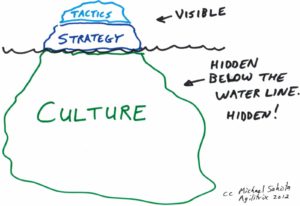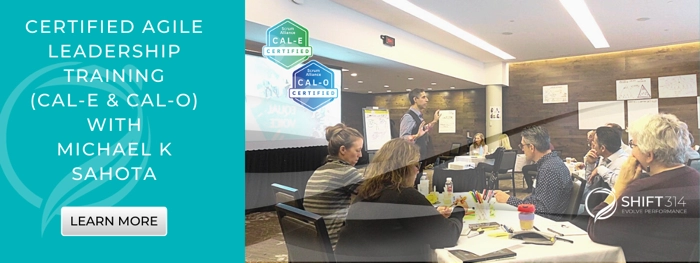The following diagram is a powerful mental frame to help understand change efforts within organizations. It makes the discernment between tactical, strategic and cultural levels. One way to use the diagram is to position each change item or activity on the line to show what aspect it is focussed on.
More importantly, I use the diagram to engage with clients to explore what they want to achieve, why they want to achieve it, and how invested they are in the outcome.

Some typical benefits are listed above the line. Most importantly, break-through results only come from culture – not tactical or strategic approaches.
- Tactics – “How do we work?” is about day to day practices and process elements. These are things that a team or organization can adopt.
- Strategy – “What do we want to achieve” is about aligning the company around key goals and initiatives.
- Culture – “Who do we want to be?” is about clarifying the organizations reason for existing as well as it’s values and vision.
Relationship between the levels

Culture is the foundation that Strategy and Tactics sit on. But culture is like an iceberg – a powerful force that is underwater where you can’t see it. Sure it’s possible to work at the levels of tactics and strategy, but that is unlikely to make any lasting change or draw great benefits. Lasting change requires working at all three levels so that the tactics and strategy support the culture.
Relationship to Leadership Agility
Bill Joiner has identified a number of distinct mindsets that can be found with managers/leaders. and his work on Leadership Agility. The following are one to one mappings from types of leaders/mindsets:
- Experts focus on Tactics: problems and work execution.
- Achievers focus on Strategy: outcomes and the system.
- Catalysts focus on Culture: vision and break-through culture.

Acknowledgements
The deepest inspiration comes from Bill Joiner and his work on Leadership Agility and the different levels of focus. This served as the basis for my model.
I would like to thank a variety of sources for the notion of Culture being mostly hidden – I have seen or read this in a number of places but most vividly from the folks at Crucial Conversations and their book Influencer in particular.
I am grateful for Mike Cottemeyer for helping me understand the difference between Agile Adoption (Tactical) and Agile Transformation (Cultural).


